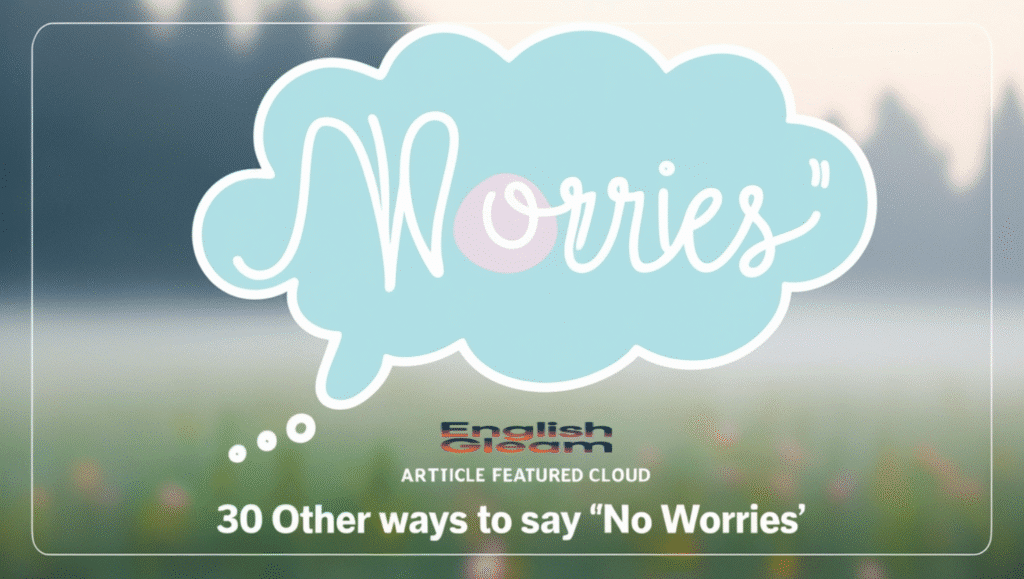Saying “no worries” means telling someone not to stress or feel bad. It’s often used to respond kindly. But many other phrases can mean the same.
Tired of repeating the same words? Want to sound more natural or polite? This list will help you sound fresh every time.
In different settings, your words matter. Casual talk and formal emails need different tones. Let’s find the right phrase for every moment.
Why Go Beyond “No Worries”?
“No worries” works in casual conversation—but it may sound too relaxed for a customer service email or stiff in formal writing. Switching it up keeps your words genuine and relevant. Plus, using varied common expressions shows you care and communicate with flair.
Quick Comparison: Formal vs Casual
| Context | Tone | Alternative | Example |
|---|---|---|---|
| Customer service email | Polite response | My pleasure | “My pleasure to help with your request.” |
| Slack team chat | Casual convo | No sweat | “No sweat—I’ve updated the doc.” |
| Business presentation | Formal statement | No cause for concern | “There’s no cause for concern about the deadline.” |
| Friend texting | Chill & warm | Anytime! | “Thanks a ton.” “Anytime!” |
💬 The 30 Alternatives Explained
Each of these options is a friendly phrase that helps you tailor your tone for the moment—whether you’re chatting at the office or texting a pal.
1. No Problem
- Tone: Casual, polite
- Use: Everyday situations
- Example:
Q: “Thanks for printing that!”
A: “No problem.”
2. It’s Okay
- Tone: Gentle, empathetic
- Use: Apology response
- Example:
“I’m really sorry about that message.”
“It’s okay. Don’t worry.”
3. Don’t Mention It
- Tone: Humble, kind
- Use: Casual thank-yous
- Example:
“Thanks for the referral!”
“Don’t mention it.”
4. You’re Welcome
- Tone: Polite response
- Use: Formal or casual
- Example:
“Thanks for your help.”
“You’re welcome!”
5. My Pleasure
- Tone: Warm, professional
- Use: Customer service, office emails
- Example:
“I’ve attached the report.”
“My pleasure—let me know if you need anything else.”
6. Happy to Help
- Tone: Helpful, caring
- Use: Both casual and formal
- Example:
“Could you review this slide?”
“Absolutely—happy to help.”
7. Anytime
- Tone: Friendly, supportive
- Use: Casual chats
- Example:
“Thanks for covering my shift!”
“Anytime!”
8. No Sweat
- Tone: Chill, upbeat
- Use: Informal, relaxed tone
- Example:
“Did you get the update?”
“Yep—no sweat.”
9. Consider It Done
- Tone: Confident, professional
- Use: Business setting
- Example:
“Can you send this by EOD?”
“Consider it done.”
10. I’ve Got You
- Tone: Reassuring, close friend style
- Use: Personal support
- Example:
“I’m swamped with work.”
“No worries—I’ve got you.”

11. Not a Big Deal
- Tone: Casual, soothing
- Use: Minor mistakes
- Example:
“Sorry I spilled coffee.”
“Not a big deal.”
12. That’s Fine
- Tone: Neutral, calm
- Use: Everyday interactions
- Example:
“I forgot to send the invite.”
“That’s fine—just do it now.”
13. No Honor Done
- Tone: Forgiving, light
- Use: When damage is minimal
- Example:
“Oops, I scratched the car.”
“No harm done.”
14. No Hard Feelings
- Tone: Forgiving, conflict-resolution
- Use: After disagreements
- Example:
“I can’t make the last meeting.”
“No hard feelings.”
15. It’s Nothing
- Tone: Modest, low-key
- Use: Minimizing effort
- Example:
“Thanks for staying late.”
“It’s nothing.”
16. No Trouble at All
- Tone: Polite, considerate
- Use: Semi-formal, kind
- Example:
“Could you resend that?”
“No trouble at all.”
17. I’m On It
- Tone: Prompt, proactive
- Use: Getting things done
- Example:
“Can you fix this now?”
“I’m on it.”
18. Sure Thing
- Tone: Cheerful, upbeat
- Use: Casual yes
- Example:
“Mind looking this over?”
“Sure thing!”
19. No Stress
- Tone: Relaxed, laid-back
- Use: Ease tension
- Example:
“I’m late sorry!”
“No stress.”
20. Not an Issue
- Tone: Neutral, reassuring
- Use: Professional or formal
- Example:
“Can we delay that deadline?”
“Not an issue.”
21. No Cause for Concern
- Tone: Formal, calming
- Use: Official statements
- Example:
“Will we meet the target?”
“There’s no cause for concern.”
22. It’s Alright
- Tone: Gentle, friendly
- Use: Casual
- Example:
“I messed up the file.”
“It’s alright—just fix it.”
23. Forget About It
- Tone: Casual, dismissive
- Use: Brushing off errors
- Example:
“Sorry I lost the notes.”
“Forget about it.”
24. You Got It
- Tone: Encouraging, easygoing
- Use: Task approval
- Example:
“Could you handle this?”
“You got it!”
25. Absolutely!
- Tone: Enthusiastic, affirmative
- Use: Excited yes
- Example:
“Think you can help?”
“Absolutely!”
26. No Need to Apologize
- Tone: comforting, understanding
- Use: When no apology is needed
- Example:
“I’m sorry to bother you.”
“No need to apologize.”

27. It’s All Good
- Tone: Relaxed, laid-back
- Use: Chill clarification
- Example:
“Am I late?”
“It’s all good.”
28. Nothing to Worry About
- Tone: Reassuring, sincere
- Use: Calming anxiety
- Example:
“Is this going to ruin everything?”
“Nothing to worry about.”
29. I’ve Got It Covered
- Tone: Confident, secure
- Use: Business, tasks
- Example:
“Need someone to run that?”
“I’ve got it covered.”
30. Consider It Taken Care Of
- Tone: Strong, professional
- Use: Office or teamwork
- Example:
“Can you order those supplies?”
“Consider it taken care of.”
How to Pick the Right Phrase in a Casual Conversation vs Formal Setting
📌 Casual Chat
Use: No sweat, Forget about it, You got it—these feel natural and friendly.
📘 Professional or Customer Service Setting
Opt for: My pleasure, No trouble at all, Consider it done—they show polish while staying courteous.
📞 Apology Response
Choose: It’s okay, No need to apologize, No harm done—you’re offering empathy, not dismissiveness.
Tone & Use Table
| Phrase | Tone | Formal? | Casual? | Best Use |
|---|---|---|---|---|
| No Problem | Friendly | ✔ | ✔ | Everyday use |
| My Pleasure | Warm, professional | ✔✔ | Emails, service interactions | |
| No Sweat | Relaxed | ✔✔ | Informal chats | |
| No harm done | Lighthearted | ✔ | ✔ | Minor mistakes |
| Consider it done | Confident | ✔✔ | Team tasks |
🧠 Tips for Using These Alternatives Naturally
- Match tone to context.
Use “No sweat” with friends, “My pleasure” in customer chats, and “No cause for concern” when speaking to supervisors. - Avoid clichés.
Keep your expressions fresh. Swap a phrase when you feel it’s repeated too often. - Add brief reasoning.
Example: “No problem—I caught up on the report already.” - Balance enthusiasm.
Too much cheer can sound fake. It’s okay to tone down: “Sure thing” instead of “Absolutely!” - Watch your tone.
“It’s fine” risks sounding dismissive—soften it with a smile or follow-up.
Frequently Asked Questions
1. Can I use “no worries” in a professional setting?
Absolutely—but sparingly. In an office context, “no worries” works with teammates you know well. For formal emails, choose polished substitute expressions like My pleasure or No trouble at all.
2. What are good alternatives in customer service?
Best picks: Happy to help, My pleasure, No trouble at all. They’re courteous replies that keep the conversation respectful and helpful.
3. Which phrase works best in an apology response?
Try: It’s okay, No need to apologize, or No harm done. These offer sincerity and warmth when someone says “I’m sorry.”
4. Are some alternatives too informal?
Yes—phrases like No sweat, Forget about it, You got it fit casual chats. In formal writing, they might seem too relaxed. Stick with Not an issue or Consider it done.
5. How do I know which tone to choose?
Start by thinking about your relationship and setting. If you’re writing to a client or sending a professional answer, go formal. Chatting with friends? You’ve got room to loosen up the tone.
Final Thoughts
Using the same phrase over and over can sound dull. These 30 other ways to say “no worries” help keep your words fresh and kind.
Whether you’re texting a friend or writing a formal message, tone matters. Pick a phrase that fits the moment and keeps your reply warm.

William Jams is an experienced blogger at EnglishGleam, passionate about language, writing, and storytelling. With years of expertise in crafting engaging content, she aims to inspire readers through insightful articles that enhance their English skills and knowledge.






